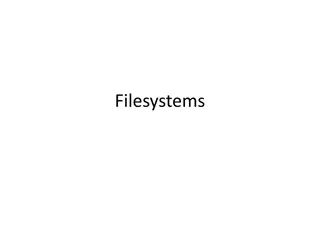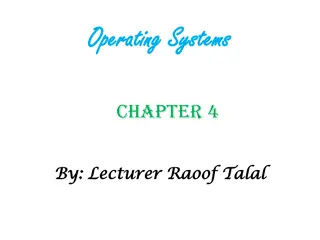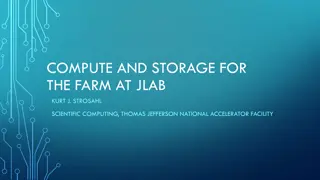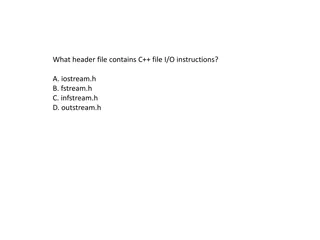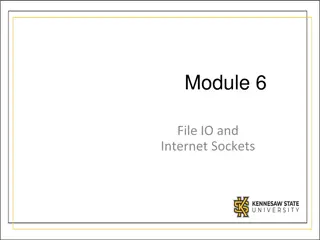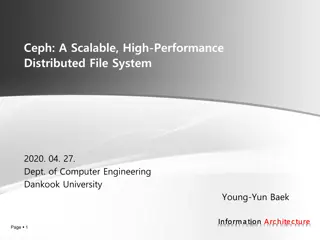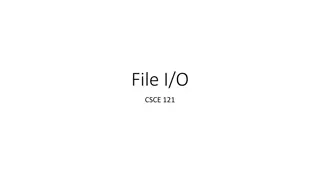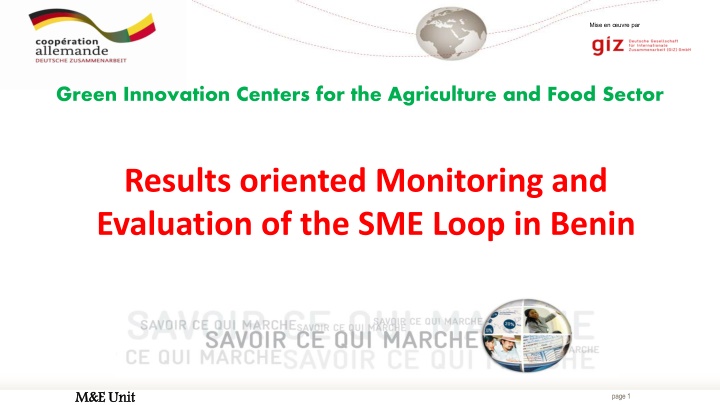
Monitoring and Evaluation Framework for SMEs in Agricultural Innovation Centers
This monitoring and evaluation framework focuses on the systematic setup and implementation of an M&E system for SMEs in Benin, particularly in the agriculture and food sector. It emphasizes activities such as baseline data collection, coaching, quarterly monitoring, and economic impact assessment. The framework also includes statistical analysis, monitoring tools, data collection methods, stakeholder involvement, and impact assessment methodology. Through a structured approach, it aims to track the progress and outcomes of SMEs, ensuring effective support and sustainable development.
Download Presentation

Please find below an Image/Link to download the presentation.
The content on the website is provided AS IS for your information and personal use only. It may not be sold, licensed, or shared on other websites without obtaining consent from the author. If you encounter any issues during the download, it is possible that the publisher has removed the file from their server.
You are allowed to download the files provided on this website for personal or commercial use, subject to the condition that they are used lawfully. All files are the property of their respective owners.
The content on the website is provided AS IS for your information and personal use only. It may not be sold, licensed, or shared on other websites without obtaining consent from the author.
E N D
Presentation Transcript
Mise en uvre par Green Innovation Centers for the Agriculture and Food Sector Results oriented Monitoring and Evaluation of the SME Loop in Benin M&E Unit M&E Unit page 1
Mise en uvre par Our M&E system 4 1. Set-up of the M&E system 8 3 2. Assessment and selection: randomized selection of beneficiaries and control group 5 3. First training: Collection of baseline data 7 4. Coaching: Monthly monitoring 5. Quarterly monitoring of SME indicators 6. Monitoring of the graduation process 6 7. Quality Control 8. Economic impact assessment 2 1 page 2
Mise en uvre par Our M&E system 4 1. Set-up of the M&E system 8 3 2. Assessment and selection: randomized selection of beneficiaries and control group 5 3. First training: Collection of baseline data 7 4. Coaching: Monthly monitoring 5. Quarterly monitoring of SME indicators 6. Monitoring of the graduation process 6 7. Quality Control 8. Economic impact assessment 2 1 page 3
Mise en uvre par 1. Set-up of the M&E System Statistical and econometric analyses based on Averages, Medians, Quartiles, Standard Deviation SME monitoring dashboard Mandatory monitoring linked to project indicators (turnover, jobs created, gender, etc.) Indicator monitoring table GIS with QGIS, Google Maps Data collection system (KoBo Collect, Excel) Thematic-oriented monitoring (Access to finance, Innovations in SMEs) Guide to fill the dashboard Data collection method (Individual interviews, Focus groups, Learning cases) Guide for the development of learning cases Stakeholders in M&E activities (M&E Unit, technical advisers SME, Service Providers, Coaches, Data Collection Consultants, APRM) Impact Assessment Methodology: Difference- in-Difference Design Dictionary of studies page 4
Mise en uvre par Our M&E system 4 1. Set-up of the M&E system 8 3 2. Assessment and selection: randomized selection of beneficiaries and control group 5 3. First training: Collection of baseline data 7 4. Coaching: Monthly monitoring 5. Quarterly monitoring of SME indicators 6. Monitoring of the graduation process 6 7. Quality Control 8. Economic impact assessment 2 1 page 5
Mise en uvre par Implementation of the randomized evaluation protocol for SMEs time 1 (baseline data) Measurement time 3 (results) Measurement QualityControl of the selection Coaching of 25 SMEs and collection of economic data 25 SMEs that benefit from SME-BTCL (I2) (I1) Validation of 35 SMEs according to SME-BTCL criteria Selection of 50 SMEs Attribution bias Evaluation bias Beginning of the coaching of 25 SMEs Random assignment Participation of the 10 SMEs of the control group in the SME-BTCL next training session 10 SMEs as controlgroup Collection of the economic data of 10 SMEs of the group of control Providers Service (C1) (C2) SME advisors M&E advisors SME advisors Service Providers End of the coaching of the 25 SMEs 09 months / 06 months Start of the process End of the process Selection bias Realisation bias ESSAI CONTR LE ALEATOIRE DANS LE CADRE DU SME LOOP Measuring the effect : (I2 - I1) (C2 - C1) page 6
Mise en uvre par Our M&E system 4 1. Set-up of the M&E system 8 3 2. Assessment and selection: randomized selection of beneficiaries and control group 5 3. First training: Collection of baseline data 7 4. Coaching: Monthly monitoring 5. Quarterly monitoring of SME indicators 6. Monitoring of the graduation process 6 7. Quality Control 8. Economic impact assessment 2 1 page 7
Mise en uvre par Our M&E system 4 1. Set-up of the M&E system 8 3 2. Assessment and selection: randomized selection of beneficiaries and control group 5 3. First training: Collection of baseline data 7 4. Coaching: Monthly monitoring 5. Quarterly monitoring of SME indicators 6. Monitoring of the graduation process 6 7. Quality Control 8. Economic impact assessment 2 1 page 8
Mise en uvre par Monthly Monitoring KoBo Collect Forms completed by Coaches: MONTHLY Assessment OF SMEs Tools implemented / Maintenance of management tools Formalization of companies Access to finance for SMEs SME progress indicators Raw material flows (processing and marketing) in kg Further activities undertaken Coach follow-up by SME advisors Difficulties encountered and approaches to solutions Data analysis for oriented monitoring Answers to requests for information page 9
Mise en uvre par Our M&E system 4 1. Set-up of the M&E system 8 3 2. Assessment and selection: randomized selection of beneficiaries and control group 5 3. First training: Collection of baseline data 7 4. Coaching: Monthly monitoring 5. Quarterly monitoring of SME indicators (-> TBS) 6. Monitoring of the graduation process 6 7. Quality Control 2 8. Economic impact assessment 1 page 10
Mise en uvre par Our M&E system 4 1. Set-up of the M&E system 8 3 2. Assessment and selection: randomized selection of beneficiaries and control group 5 3. First training: Collection of baseline data 7 4. Coaching: Monthly monitoring 5. Quarterly monitoring of SME indicators 6. Monitoring of the graduation process 6 7. Quality Control 8. Economic impact assessment 2 1 page 11
Mise en uvre par Monitoring of the graduation process Evaluation table of the graduation of SMEs and Coaches Certification criteria Possession of PED (10 pts) Formalized SME (10 pts) Possession of a business plan (10 pts) Formal job creation (With contract or pay sheet) (10 pts) Bank Account Ownership (5 pts) Employee salary higher than or equal to minimum wage (5pts) Updated journal (10 pts) Updated customer account (5pts) Increase in turnover during support (15 pts) Updated stock sheet (5pts) Total = 100 points. Establishment of written operating account by the SME after the support (10 pts) To graduate, the SME must obtain at least 50 points. Successful access to credit (5pts) page 12
Mise en uvre par Our M&E system 4 1. Set-up of the M&E system 8 3 2. Assessment and selection: randomized selection of beneficiaries and control group 5 3. First training: Collection of baseline data 7 4. Coaching: Monthly monitoring 5. Quarterly monitoring of SME indicators 6. Monitoring of the graduation process 6 7. Quality Control 2 8. Economic impact assessment 1 page 13
Mise en uvre par Quality Control Objectives Methods Make an initial assessment of the data collected in the TBS; Data quality control sheet Bias analysis sheet Correct data that are not in line with the reality of SMEs; Visit of SMEs to compare reality with data provided in the TBS dashboard Identify errors affecting data quality; Coach: identify the sources of errors in the TBS filling process Take measures to limit errors affecting data in quality; Corrective measures are taken in consultation with the coach. Validate the GERs received from providers. Quality control sheet co-signed by the coach. page 14
Mise en uvre par Our M&E system 4 1. Set-up of the M&E system 8 3 2. Assessment and selection: randomized selection of beneficiaries and control group 5 3. First training: Collection of baseline data 7 4. Coaching: Monthly monitoring 5. Quarterly monitoring of SME indicators 6. Monitoring of the graduation process 6 7. Quality Control 8. Economic impact assessment 2 1 page 15
Mise en uvre par Economic impact assessment Annual evaluation to measure the long-term effects of the SME Loop; Themes addressed: Job creation; Evaluation at the end of the coaching; Evolution of turnover; Two impact questionnaires; Functionality of SMEs; Data on 06/09 before, during and after coaching; Access to financing; Interviews of SMEs supported; Changes / innovations introduced with the support of ProCIVA; Interviews with SME witnesses Focus groups; Evaluation of Project Support Learning cases; Information on innovation activity; page 16
Mise en uvre par page 17
Mise en uvre par THANK YOU FOR YOUR ATTENTION page 18





